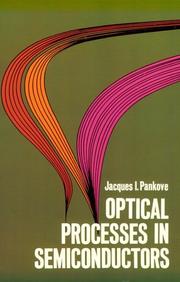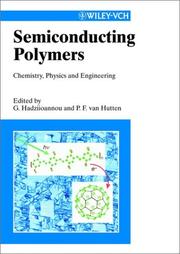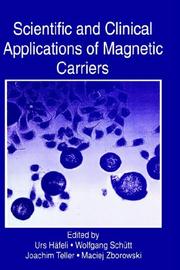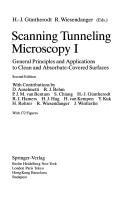| Listing 1 - 6 of 6 |
Sort by
|

ISBN: 0486602753 Year: 1975 Publisher: New York Dover Publications
Abstract | Keywords | Export | Availability | Bookmark
 Loading...
Loading...Choose an application
- Reference Manager
- EndNote
- RefWorks (Direct export to RefWorks)

ISBN: 3527295070 Year: 2000 Publisher: Weinheim Wiley-VCH
Abstract | Keywords | Export | Availability | Bookmark
 Loading...
Loading...Choose an application
- Reference Manager
- EndNote
- RefWorks (Direct export to RefWorks)
Polymers --- Electronics --- Organic semiconductors --- Semiconductor doping --- Semiconducteurs organiques --- Polymères --- Semiconducteurs --- Electronique --- Materials --- Electric properties --- Optical properties --- Propriétés électriques --- Propriétés optiques --- Dopage --- Matériaux --- 678.01:537 --- -Organic semiconductors --- -Polymers --- -Semiconductor doping --- #WSCH:MODS --- Doping of semiconductors --- Diffusion --- Doped semiconductors --- Semiconductors --- Polymere --- Polymeride --- Polymers and polymerization --- Macromolecules --- Electrical engineering --- Physical sciences --- Properties. Defects. Constitution. Serviceability. Sampling. Analysis. Testing-:-Electricity. Magnetism. Electromagnetism --- Defects --- 678.01:537 Properties. Defects. Constitution. Serviceability. Sampling. Analysis. Testing-:-Electricity. Magnetism. Electromagnetism --- Polymères --- Propriétés électriques --- Propriétés optiques --- Matériaux --- Electronic materials

ISBN: 0306456877 1441932836 1475764820 Year: 1997 Publisher: New York (N.Y.) Plenum
Abstract | Keywords | Export | Availability | Bookmark
 Loading...
Loading...Choose an application
- Reference Manager
- EndNote
- RefWorks (Direct export to RefWorks)
The discovery of uniform latex particles by polymer chemists of the Dow Chemical Company nearly 50 years ago opened up new exciting fields for scientists and physicians and established many new biomedical applications. Many in vitro diagnostic tests such as the latex agglutination tests, analytical cell and phagocytosis tests have since become rou tine. They were all developed on the basis of small particles bound to biological active molecules and fluorescent and radioactive markers. Further developments are ongoing, with the focus now shifted to applications of polymer particles in the controlled and di rected transport of drugs in living systems. Four important factors make microspheres interesting for in vivo applications: First, biocompatible polymer particles can be used to transport known amounts of drug and re lease them in a controlled fashion. Second, particles can be made of materials which bio degrade in living organisms without doing any harm. Third, particles with modified surfaces are able to avoid rapid capture by the reticuloendothelial system and therefore en hance their blood circulation time. Fourth, combining particles with specific molecules may allow organ-directed targeting.
Magnetic separation. --- Biomagnetism --- Biomolecules --- Séparation magnétique --- Biomagnétisme --- Biomolécules --- Magnetic properties --- Propriétés magnétiques --- 537.635 <063> --- -Magnetic separation --- Separation (Technology) --- Biological molecules --- Molecules --- Molecular biology --- Biological magnetism --- Magnetism, Biological --- Biophysics --- Electromagnetism --- Electrophysiology --- Human body --- Magnetic resonances--Congressen --- Magnetic fields --- 537.635 <063> Magnetic resonances--Congressen --- Séparation magnétique --- Biomagnétisme --- Biomolécules --- Propriétés magnétiques --- Magnetic separation --- Biophysics. --- Biological physics. --- Biological and Medical Physics, Biophysics. --- Biological physics --- Biology --- Medical sciences --- Physics
Book
ISBN: 3540513914 0387513914 3642613381 Year: 1989 Volume: 75 Publisher: Berlin Springer
Abstract | Keywords | Export | Availability | Bookmark
 Loading...
Loading...Choose an application
- Reference Manager
- EndNote
- RefWorks (Direct export to RefWorks)
Semiconductors --- Electronic structure --- Energy-band theory of solids --- Semiconducteurs --- Structure électronique --- Energie, Bande d' (Physique) --- Optical properties --- Propriétés optiques --- -Electronic structure --- Band theory of solids --- Conduction band --- Crystallography, Mathematical --- Electrons --- Exciton theory --- Molecules --- Quantum theory --- Solids --- Wave mechanics --- Structure, Electronic --- Atomic structure --- Crystalline semiconductors --- Semi-conductors --- Semiconducting materials --- Semiconductor devices --- Crystals --- Electrical engineering --- Electronics --- Solid state electronics --- Materials --- Structure électronique --- Propriétés optiques

ISBN: 9780521544108 0521544106 0521472067 9780521472067 9780511600333 Year: 1996 Publisher: Cambridge Cambridge University Press
Abstract | Keywords | Export | Availability | Bookmark
 Loading...
Loading...Choose an application
- Reference Manager
- EndNote
- RefWorks (Direct export to RefWorks)
Light emitting diodes --- Polymers --- Surface chemistry --- Polymères --- Chimie des surfaces --- Materials --- Surfaces --- Electric properties --- Propriétés électriques --- -Polymers --- -Surface chemistry --- Chemistry, Surface --- Interfaces, Chemistry of --- Surface phenomena --- Surfaces (Chemistry) --- Chemistry, Physical and theoretical --- Capillarity --- Surface energy --- Surface tension --- Surfaces (Physics) --- Polymere --- Polymeride --- Polymers and polymerization --- Macromolecules --- LEDs (Light emitting diodes) --- Diodes, Semiconductor --- Electroluminescent devices --- LED lamps --- Light-emitting electrochemical cells --- Polymères --- Propriétés électriques --- Materials.

ISBN: 0387543082 0387545557 0387563172 3540543082 3540545557 3540563172 3642973450 3642973434 3642973655 3642973639 3642974724 3642974708 9783540543084 9783540545552 9783540563174 Year: 1993 Volume: 20, etc. Publisher: Berlin Springer
Abstract | Keywords | Export | Availability | Bookmark
 Loading...
Loading...Choose an application
- Reference Manager
- EndNote
- RefWorks (Direct export to RefWorks)
Scanning tunneling microscopy --- Surface chemistry --- Surfaces (Physics) --- Microscopie à effet tunnel --- Chimie des surfaces --- Surfaces (Physique) --- Optical properties --- Propriétés optiques --- Scanning tunneling microscopy. --- Optical properties. --- 531.728 --- 537.533.35 --- -Physics --- Surfaces (Technology) --- Chemistry, Surface --- Interfaces, Chemistry of --- Surface phenomena --- Surfaces (Chemistry) --- Chemistry, Physical and theoretical --- Capillarity --- Surface energy --- Surface tension --- STM (Microscopy) --- Scanning probe microscopy --- Surface measurement using microscope --- Electron microscopy --- -Surface measurement using microscope --- 537.533.35 Electron microscopy --- 531.728 Surface measurement using microscope --- -Chemistry, Surface --- Microscopie à effet tunnel --- Propriétés optiques --- Scanning probe microscopy. --- Scanned probe microscopy --- #WSCH:MODS --- Scanning electron microscopy --- Physics --- Experimental solid state physics --- Surfaces (Physics) - Optical properties.
| Listing 1 - 6 of 6 |
Sort by
|

 Search
Search Feedback
Feedback About UniCat
About UniCat  Help
Help News
News